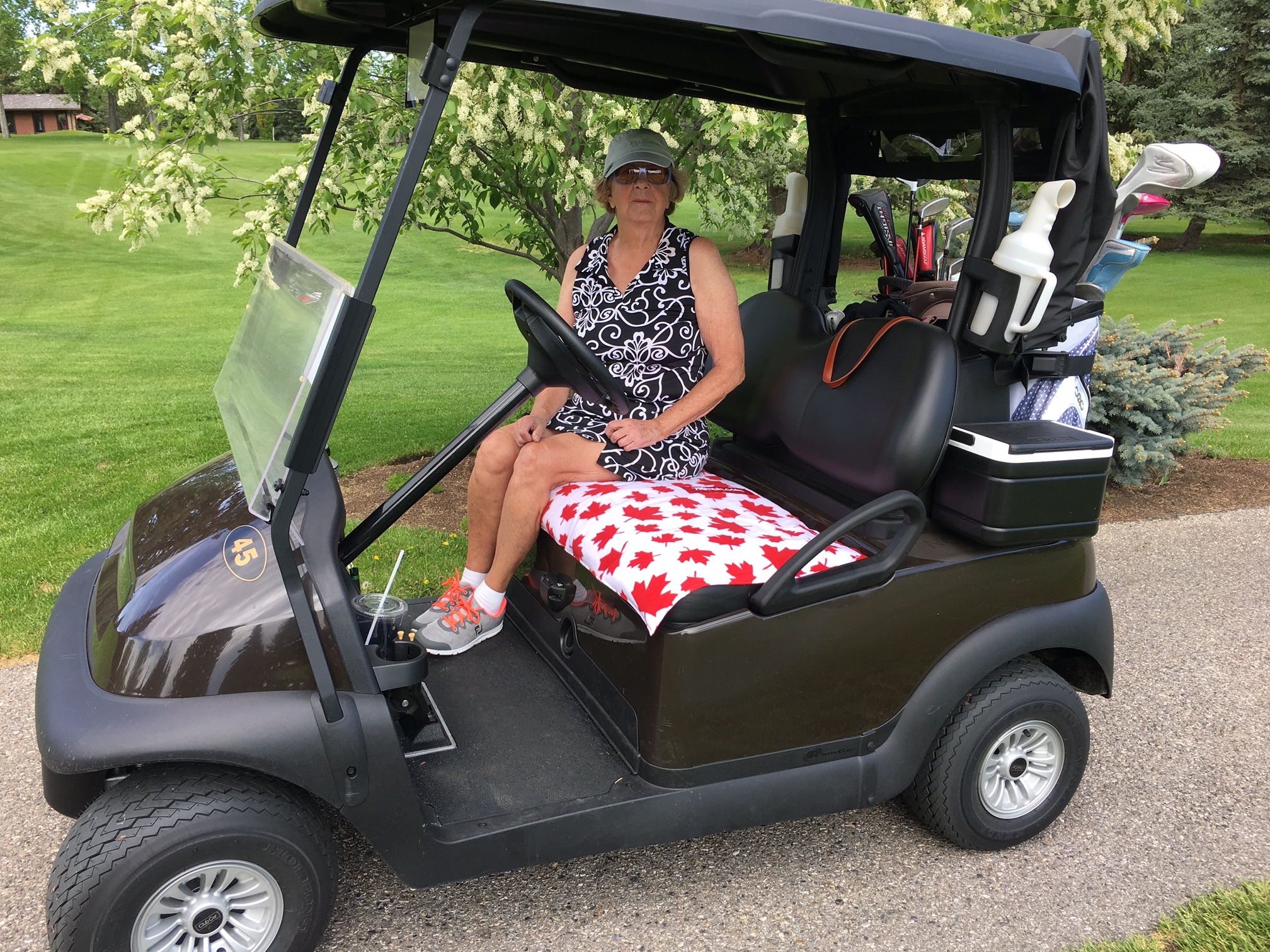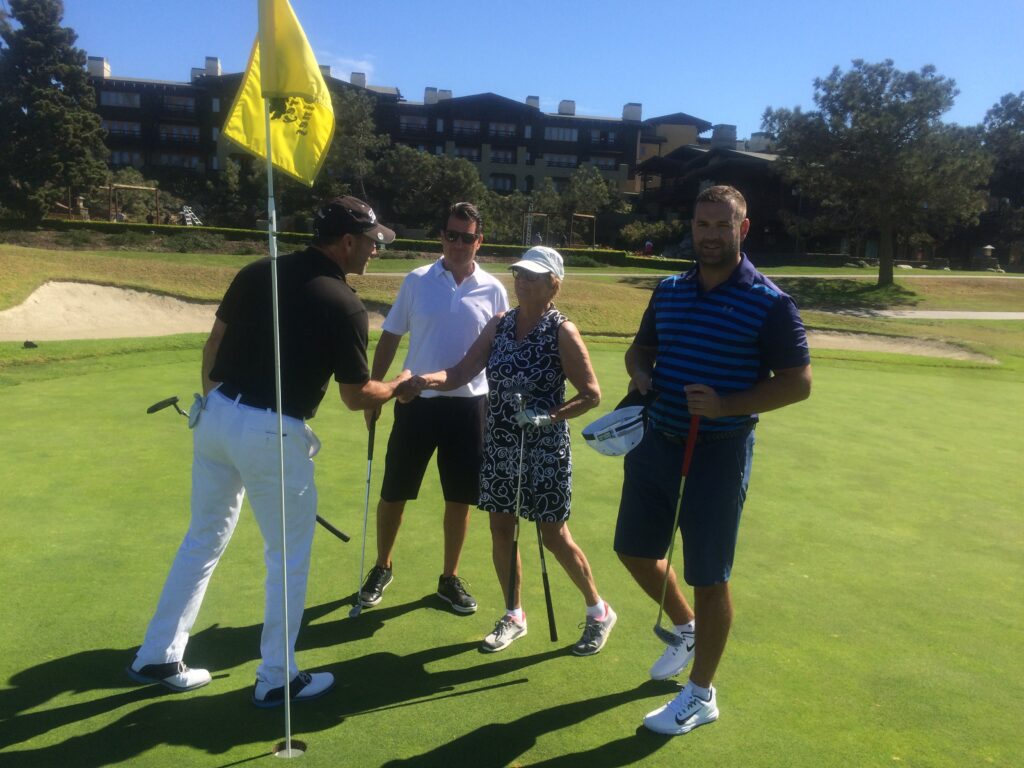Many people play the game on Golf and just go out to hit a little white ball around the 18 holes. They neither know or care to know the Rules and Etiquette pertaining to the game. And that is fine with me. HOWEVER to play competitively, even a beginner needs to know the basics rules.
Golf is a game that can be played alone or with one or more players but only in rare places a group of five. Four is the maximum number allowed for one tee time at most golf courses. Golfing can be fun, enjoying the company of others and you can be as competitive as you desire. It is expected that you play in 4 and 1/2 hours. That is about 15 minutes per hole. Sometimes it takes a little less on Par 3’s and sometimes a little more on Par 5’s.
As with all sports there are rules pertaining to the game be it hockey, soccer, baseball, softball, basketball, cricket, horse racing, etc. and golf. Even as a young child in elementary school we played softball and played by the rules. My Dad and Uncle came to Canada from the USA at the age of 15 and of course played ball as a youngster and knew the rules. And that’s how our generation were taught by our parents the rules of any sport we participated in!
Rules of Golf
as approved by
Golf Canada,
R&A Rules Limited, and
The United States Golf Association
Effective January 2019
There are 243 pages in these rules and they are the same for Canadian and the United States. It is not expected that everyone memorize this rule book or that only those playing competitive or professional golfers should know the rules. However those in an official position at a club should know the rules and be able to find any rule in the book pertaining to any question that arises during regular play.
The Provincial level with the Canadian LPGA was very active in keeping all member clubs up to date. Not only were slope and rating of each course reviews on a regular bases but clinics were carried on at each club. Computerized handicap programs were put into each club but that also required clinics as with any program you need to know what your proper INPUT needs to be! Knowledge of the difference between Index and Handicap is imperative if you are competing in any competition at your home club or at any other club. Rules clinics are conducted on a regular bases for every club and SHOULD be attended as rules do change over time. Provincial tournaments are supervised by the association to ensure that all rules are adhered to by their exceptionally trained officials.
But it is also up to you to know the basic rules: what consists of (1) no penalty, (2) a one stroke penalty and (3) a two stroke penalty. How to take relief from various positions your ball may be on a golf course. What are red stakes as compared to yellow stakes? What are your options if your bill is in the trees or out of bounds? These are basic rules that you should know.
Sand bagger is a term generally applied to a golfer who’s Handicap/Index is higher than it actually is! It is very rare that a golfer with a high 35-40 handicap comes out of the blue and shoots a gross score of 88, especially if this is a new to them golf course!
Today we use handicaps as a system of checks and balances to help reduce sandbagging. That said, the system inherently relies on the trustworthiness of the golfer. Some golfers only put their highest scores into the “system” and I have seen many realize they are having “too good” a game close to the next of a round and take what I think are intentionally high scores on the last few holes. The only prizes that are effected are LOW NET scores and in my opinion these prizes should be eliminated as LOW GROSS is the only score that can truly be validated in any golf competition.
If you belong to a Ladies Club, here in Canada or the USA the rules are the same. You must enter into the computerized handicap program ALL all games that you have played regardless of which country you carry your handicap card with. If you belong to a club in Canada, or just subscribe to Golf Canada to keep your Handicap and you play any games outside Canada YOU MUST enter these games into the system. The same rule applies if you belong to a club in the USA and play games outside that country. ALL GAMES PLAYED MUST BE ENTERED AS REQUIRED BY THE RULES OF GOLF.
I remember playing in a Provincial Tournament in Prince Albert, Saskatchewan and it was a Team Competition. After the scores were posted the final day we waited for the Prize Presentations and the Banquet to be served. We waited and we waited and we waited. Finally we saw the Tournament Committee summoned the individuals of the leading team one at a time to the Official Score keeping Office. The leading team was disqualified and the team that was in second place was announced the winner and all prizes were given out. The original leading team had not been keeping their handicaps correctly. The Provincial President apologized for the delay and announced that the Handicap Chairman would be holding a seminar at this club to bring them up to date on both Handicap and Index procedures and policies.
When I started golfing regularly at the Murray Golf Course Ladies Club in Regina, SK it was the members who played with the beginners and they taught them the rules and etiquette right from the start. Rules and Handicap clinics were conducted every year and you were required to attend! I was given or I bought the rules book at that time. Many revisions of the rules have replace my first book since that time.
AT THE GOLF COURSE
There are usually a few local rules on the scorecard of the course you are playing and you should check these out before you play. There are unwritten rules that are just common sense.
- Be at the golf course in plenty of time to warm up on the range and check out the speed of the putting green.
- Check in with the starter when you arrive and be at the designated tee box NO less than 10 minutes before your tee time.
- Keep up to the group in front if you. As long as they are out of range you may hit your ball but don’t rush your shots. Driving your golf car fast to your ball makes you rush your shots or your playing partners shots. Slow down. The time you take to set up properly usually avoids another shot!

We’ll go over the variations of golf cart rules you might see posted at your local golf courses, but first, here are a couple reminders of things you should never do in a golf cart:
- Never drive the cart within hazard boundary lines, or within about 10 yards of water hazards or bunkers, or within about 30 yards of greens (unless you’re on a designated cart path, of course). These areas are especially susceptible to damage by the wheels of golf carts. Never drive onto or close to tee boxes, either, unless on the cart path.
- Never drive the cart through mud, on or off the fairway.
- Never drive through casual water on any part of the golf course (unless it’s a little bit of water over a paved cart path). The wheels of the cart can do serious damage to the turf, including leaving ruts, in wet areas.
- Never go joyriding in the golf cart. In other words, don’t act stupid! People do get injured in cart accidents. See golf cart safety for specific suggestions.
Now, as mentioned above, golf courses may post notices about specific golf cart rules depending on conditions at the course that day. These notices may be posted in the clubhouse; sometimes courses use small signs they stick in the ground alongside the cart path on the route to the first tee. You should always ask when you check in what the course’s standard golf cart rules are, then also be alert for any signage. What might the signage specify?
Cart Path Only
A “cart-path-only rule” is exactly what it sounds like: Keep your golf cart on the designated cart path at all times. Don’t drive onto the grass.
Over time, golf carts speed up soil compaction, which can lead to less-than-ideal growing conditions for turf grasses. And that can lead to less-than-ideal fairways for golfers. So even when “cart path only” is not in effect, it’s a good idea to keep the cart on the designated path.
90-Degree Rule In Effect
The “90-degree rule” means that the golf course is allowing carts onto the grass — but only at 90-degree angles from the cart path. In other words, don’t drive the golf cart up the middle of the fairway from the tee box to your golf ball. Stay on the cart path until you are level with your golf ball, then make a 90-degree turn off the cart path and drive straight across to the ball.
Extra-Credit Golf Cart Etiquette
A few more bits of golf cart etiquette:
- Always stay on designated cart paths on par-3 holes. Even if the course allows carts onto the fairways on par-4s and par-5s, stay off the grass on par-3s.
- Observe common-sense driving rules, just as you do in your car on the road. Be especially careful at any cart-path intersections and in areas where bottlenecks occur.
- If you need to drive the cart quickly around the course (maybe you left a club behind a few holes back, maybe you badly need to find a restroom, etc.), be aware of golfers you are passing by. If a golfer is about to swing or attempt a putt, slow down as you approach and stop the cart until the golfer has completed his or her stroke. Carts are noisy. Be courteous. You wouldn’t want someone else making noise during your backswing, don’t do it to others with your cart.
- Along the same lines, many golf carts beep when they are in reverse. So if you need to put the cart in reverse, be aware of any golfers close to you and whether they are about to begin a stroke.
- When you finish a hole, walk off the green, get into the cart and move on to the next teeing ground before marking the scorecard. In this way, you won’t hold up any group behind you that is waiting for the green to clear.
- Thank and shake hands with the people you played with.

I have tried to cover what I consider a condensed overview of golf rules and etiquette. It is no way intended to take away what your golf club should inform you with clinics on a regular basis. Check with your club executive for dates of Rules, Handicap, and other CLINICS to be held and be sure to attend. It is the responsibility of your club to keep you up to date.
I hope you know more about golf now

Comments are closed.